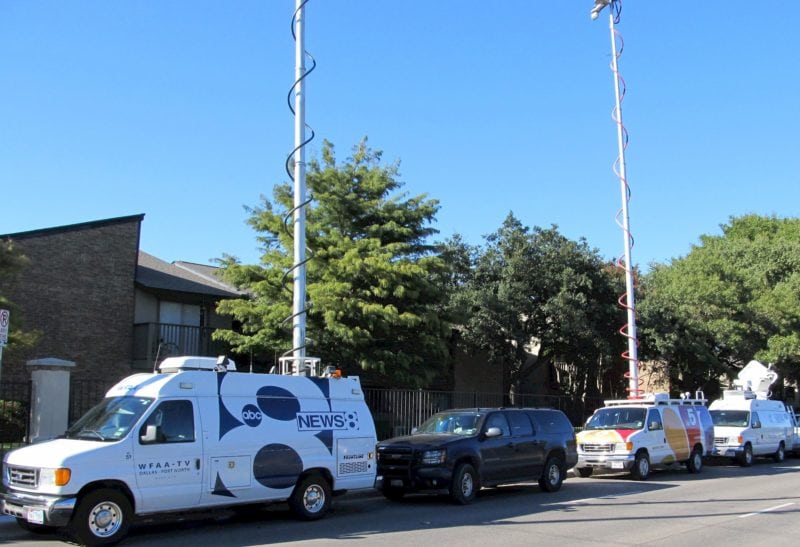IRG on Satellite in the Future of Broadcasting

Outside Broadcasting (OB) trucks uplinking to satellite. Photo: Satellite Interference Reduction Group (IRG)
Next month, along with many others, I will be heading to the International Broadcasting Convention (IBC) in Amsterdam. Over recent years the massive shifts in the broadcast industry have been reflected in a changing show, including the appearance of new halls and sections and evolving themes. It is hardly surprising considering that in just a few short years, consumers have gone from watching everything on linear TV to consuming a vast amount of content from numerous content sources and on multiple devices.
The one thing that is always a shame, however, is that satellite doesn’t feature prominently, especially given that satellite continues to be a key enabler of broadcast video.
OTT, VOD, IP…

Satellite Interference Reduction Group (IRG) Executive Director Martin Coleman. Photo: IRG
Satellite broadcasters are facing stiff competition from a variety of different places. Over-The-Top (OTT) has exploded, with many consumers signing up for multiple services. In the U.K., Ofcom recently reported that Subscription Video on Demand (SVOD) subscriptions have now surpassed that of pay TV. Revenue generated from pay TV has also dropped, according to the report. The picture is not quite so pessimistic in the U.S. where linear TV still dominates, according to Nielsen.
The trend for multiple subscriptions also still extends to pay TV. So although some of the statistics look bleak — and many are predicting widespread cord cutting — many consumers still have pay-TV subscriptions, as well as sign up to one or more OTT services.
The challenge for satellite in the broadcast space is more complex. According to Northern Sky Research, 60 percent of satellite capacity revenue is from broadcast video. Yet broadcasters, in an effort to become more cost-efficient and compete in a saturated market, are looking for other ways to contribute and distribute video. Some have already turned to a fully Internet Protocol (IP) workflow and many others look to move that way. This is a daunting prospect for many satellite operators who naturally want to keep this important piece of the pie.
The Role of Satellite
Despite everything, I don’t think satellite will lose its role in broadcast anytime soon. There are a number of reasons why it will remain relevant in the foreseeable future.
Firstly, satellite is sometimes the only method available. Outside Broadcasting (OB) trucks need to be able to uplink using satellite, because when they are called to an event or breaking news, there may not be another way of getting the signal back to the control center.
In some regions of the world, satellite TV is the most efficient — or sometimes even the only — way of receiving a TV signal. Many rural places still struggle with poor or non-existent broadband, especially in the developing world. If it weren’t for satellite TV, these areas wouldn’t get TV at all.
Additionally, I believe satellite has an important role to play to complement these new technologies. One example is a niche sports provider, MSTV Live Broadcasting, who successfully marries satellite with IP to deliver niche sports to its global audience. By using satellite to deliver the sports over IP rather than over Radio Frequency (RF), they are able to affordably deliver their service.
What Can the Satellite Industry Do?
The satellite industry has a great opportunity to enable the new realm of video broadcast and the constantly connected consumer. Sometimes it may be as a backup, other times as a complement to existing services or an enabler, and other times it may be the only connection. In order to maximize the opportunity, the operators need to see these new video providers as potential customers rather than a threat to existing client services.
The other challenge is that satellite sometimes gets a bad reputation from the broadcast industry. After all, it was the broadcast industry that first complained about satellite interference. With so many different ways of getting video, consumers don’t have patience for any downtime and so broadcasters —wary of service interruption, will likely look for other methods if they feel they cannot rely upon it. Therefore, improving quality of service and reducing degradation — whether from satellite interference or other sources — needs to remain a top priority for all satellite operators.
Implementing new technology to overcome the management of the growing complex array of services offered is key. I am a great believer in adding more automation to the management and operations process. As an example, broadcast networks often require numerous contribution satellite feeds to run a daily news operation. Many come from familiar sources, but networks must frequently acquire a satellite feed in which the parameters of the signal are unknown or have been incorrectly conveyed by telephone. Accessing the feed then requires a complex process of trial-and-error by skilled technicians to arrive at the right configuration. This can now be solved by automation management systems — from often hours to seconds!
This is just one example of what is possible. Another example is technology that utilizes metadata to allow end-to-end control of content, advertising, and monetization across today’s diverse television distribution environment.
Finally, the satellite industry needs to blow its own trumpet more. Satellite is amazing and continues to achieve great things, but most people don’t realize just how many things rely on a constant satellite connection to simply work. I rest my case.